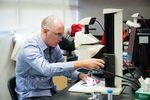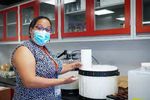ASE is finding local options for field courses
←
→
Page content transcription
If your browser does not render page correctly, please read the page content below
ASE is finding local options for field courses The pandemic has been a real challenge for the teachers and organisers of ASE’s numerous field courses, but everyone seems to agree that dropping the field components of our programme is not an option. Recently ES3002 Structural Geology and Tectonics, which used to run in Taiwan, was carried out on St. John’s Island and Lazarus Island here in Singapore. Arranging field courses always involves a lot of work for course organisers, and now managing safe distancing during activities and finding accommodation that comply with Covid regulations adds to that. For example, the dormitory at St John’s Island National Marine Laboratory could not house the whole class due to covid restrictions, and the camp ground was closed. In the end the ES3002 students stayed in smaller groups on boats, and used a rotating schedule for different field sites during the day. These solutions worked really well thanks to experienced and dedicated instructors/coordinators. It may not have been overseas, but many of the students had not previously visited St John’s and Lazarus islands, so they got to know a new corner of their home country. Importantly, the weather was good, and the night sky was apparently quite stunning. Moments from ES3002, Structural Geology and Tectonics, March Around ASE more creative replacements of overseas field trips are popping 2021. Photos by Raquel and Silei. up; for example overnight field courses in Pulau Ubin are planned later this year, and Benoit Taisne has been installing measuring instruments for environmental data around ASE with his students. Necessity is the mother of invention!
Awards, Recognition, and Grants • Ong Xin Rui and Elenaor Slade have been awarde a Wildlife Reserves Singapore Conservation Fund (WRSCF) for “Integrating genetic data to construct dung beetle-mammal trophic networks in Southeast Asian forest canopies.” • The research group Genomics and Ecology of Eukaryotes, headed by Adriana Lopes dos Santos, has been awarded the "CNRS IEA (International Emerging Action) « Green voyage : Genome evolution in the green lineage" in collaboration with Biologie Intégrative des Organismes Marins lead by Gwenael Piganeau from Observatoire IEA grant awarded to Adriana’s Océanologique Banyuls sur mer, France. group to study the Chlorophyta. • Ben Horton has been awarded the NEA NSLP grant for “Driving mechanisms of past and present sea-level change to quantify projection uncertainties”, and also and MOE Tier 2 grant for “Relative sea-level changes along the Northern Sea Route: from patterns and rates to drivers and mechanisms”. • Adam Switzer has been awarded the NEA NSLP grant for “Assessing Extreme Sea Level Exposure for Singapore and the central Sunda Ben Horton and Adam Switzer Shelf Region”. received grants to study sea level rise. CONGRATULATIONS ALL! Strategic Review completed The first strategic review of ASE has been completed. A big thank you to Patrick Martin for your efforts with this. Below is a small taste of the content: • Despite being a young, small school, ASE differentiates itself by focusing on a region of the world that is less studied by some of the globally leading institutions, and by its disciplinary diversity, which allows the school to have more scientific impact. • The EESS and ESPP programmes have increased to a cohort size of 40–45, but remain highly selective, with 250–300 applicants per year and admission rates of 10–16%. “The increase in faculty, research staff and students … has been matched by an increase in laboratories and instruments,
many of which were/are developed with EOS. The range and quality of Finance (5%) laboratories for environmental Further study (7%) Sustainability (19%) research at ASE is also rather unique in Southeast Asia, and has been an NGO (7%) additional way to attract new collaborations and a resource for Other (7%) regional capacity building.” Quote Analytics (14%) Subsequent career from the ASE Strategic Review, page path for ASE 19. Government (10%) graduates. Figure from ASE Strategic Geotech. Eng. (11%) Research (10%) Review 2021. Environmental Consulting (10%) Updates from groups within ASE new feature of newsletter As you can see below, this newsletter includes updates from ASE/EOS Research Fellows and from the ASE Alumni Association. These updates are intended to be permanent features of the newsletter. From next month there should also be updates from ASE MSOs, ASE PhD students and the ASE Club. Update from the ASE/EOS Research fellows The Research Fellows have had two seminars as part of the professional development series, the first with Anna and Perinne on managing collaborations and the second with Shengji on planning an academic career. Last month they had the communication and outreach seminar with (other) Anna and Lauriane. They also had a social 'wellbeing' meet up, and are looking ASE/EOS Research fellows meeting. forward to when socials become allowed again. The ASE Alumni Association (AA) – introduction and recent events The AA aims too: 1) Establish our alumni base: we aim to build a close-knitted community of graduates, undergraduates as well as Faculty from ASE/EOS. 2) Connect beyond the ASE community: we aim to connect with other Alumni communities, industry partners and research centres, providing more ASE Alumni at the launch of the Alumni Association. opportunities for AA members to tap into a diverse pool of skills and expertise (both within and beyond the field of earth science)
3) Impact the wider community: We desire to contribute to our local community through various means, such as volunteer activities and raising public awareness on environment-related issues. The AA held an Alumni bonding workshop (DIY coaster-making by Concrete Everything) in October 2020 and set up industry-specific Micro-networks to organise alumni from different industries into groups. We hope that these micro-networks would grow to become an effective platform for the Alumni to share experiences and opportunities and facilitate intra- and inter- industry collaborations. To engage the undergraduates, AA also organised its second “Campus to Career” Webinar in January 2021 where alumni from various sectors (Public & Civil service, Corporate sustainability & Governance and Education & Research) were invited to be part of a panel session. The panellists shared about their roles and industries, skills gained from ASE that benefitted them in their jobs as well as provided advice and suggestions to the Photos from the lauch of the ASE undergraduates on internships and jobs. Alumni Association in November 2019. In the upcoming months, we are planning for more events to engage the alumni, such as networking opportunities and webinars." Some recent publications and outreach from ASE (ASE/EOS authors in bold. The list is not in alphabetical order and does not necessarily include every recent published paper from ASE/EOS, but aims to give a taste of some new research published from ASE/EOS recently, and the incredible diversity of topics we publish on). C.W.J. Tan, C. Gouramanis, T.D. Pham, D.Q. Hoang, A.D. Switzer. 2021. Ostracods as pollution indicators in Lap An Lagoon, central Vietnam. Environmental PhD student Christabel Tan and co- authors published on ostracodes Pollution. (see photo). Check out their blog Eleanor M. Slade, Felipe S. Bufalo, Giovana C.Magro-de-Souza, Lucas A.Pereira, post on the EOS blog! Laurence Culot. 2021. Identifying the anthropogenic drivers of declines in tropical dung beetle communities and functions. Biological Conservation. Jennifer S. Walker, Robert E. Kopp, Timothy A. Shaw, Niamh Cahill, Nicole S. Khan, Donald C. Barber, Erica L. Ashe, Matthew J. Brain, Jennifer L. Clear, D. Reide Corbett & Benjamin P. Horton. 2021. Common Era sea-level budgets along the U.S. Atlantic coast. Nature Communications. Lujia Feng, Tengfei Zhang, Tieh-Yong Koh, Emma M. Hill. 2021. Selected Years of Monsoon Variations and Extratropical Dry-Air Intrusions Compared with the Ahmad Mohtar used corals as Sumatran GPS Array Observations in Indonesia. Journal of the climate proxies to study the Meteorological Society of Japan. Ser. II
Western Pacific Warm Pool Mohtar, A. T., Hughen K. A., Goodkin N. F., Streanga I-M., Ramos R. D., Samanta (WPWP) the El-Niño Southern D., James Cervino, Adam D. Switzer. (2021). Coral-based proxy calibrations Oscillation (ENSO). constrain ENSO-driven sea surface temperature and salinity gradients in the Western Pacific Warm Pool. Palaeogeography, Palaeoclimatology, Palaeoecology. Shaoneng H, Jackisch D, Samanta D, Kho P, Yi Y, Liu G, Wang X, Goodkin NF. 2021. Understanding tropical convection through triple oxygen isotopes of precipitation from the Maritime Continent. Journal of Geophysical Research: Atmospheres. Ong JJL, Walter JA, Jensen OP & Pinsky ML. 2021. Global hotspots of coherent Eleanor Slade published on marine fisheries. Ecological Applications. antropogenic drivers of tropical Valdir Felipe Novello, Francisco William da Cruz…, Xianfeng Wang et al. 2021. dung beetle decline. Investigating delta C-13 values in stalagmites from tropical South America for the last two millennia. Quaternary Science Reviews. Lythgoe, K. H., Muzli, Bradley K., Wang T., Nugraha A. Dian, Zulfakriza, et al. (2021). Thermal squeezing of the seismogenic zone controlled rupture of the volcano-rooted Flores Thrust. Science Advances. Jiayuan Yao, Shaolin Liu, Shengji Wei, Judith Hubbard, Bor‐Shouh Huang, Meng Chen, Ping Tong (2021). Slab Models Beneath Central Myanmar Revealed Karen Lythgoe and co-authors by a Joint Inversion of Regional and Teleseismic Traveltime Data. Journal of published on the 2018 Lombok Geophysical Research - Solid Earth. earthquake. Luo, H., Wang T., Wei S., Liao M., & Gong J. (2021). Deriving Centimeter-Level Coseismic Deformation and Fault Geometries of Small-To-Moderate Earthquakes From Time-Series Sentinel-1 SAR Images. Frontiers in Earth Science. Grau-Andrés, R., Wardle, D. A., Nilsson, M.-C. and Kardol, P. (2021) Precipitation regime controls bryosphere carbon cycling similarly across contrasting ecosystems. Oikos Pérez Izquierdo, L., Clemmensen, K., Strengbom, J., Granath, G., Wardle, D. A., Joyce Ong published on marine Nilsson, M.-C., Lindahl, B. (2021). Crown-fire severity is more important than fisheries. ground-fire severity in determining soil fungal community development in the boreal forest. Journal of Ecology Hyodo, F., Takebayashi, Y., Makabe, A., Wardle, D. A. and Koba, K. (2021) Changes in stable nitrogen isotopes of plants, bulk soil, and soil dissolved N during ecosystem retrogression in boreal forest. Ecological Research. Jimenez, V., Burns, J. A., Gall, F. L., Not, F., & Vaulot, D. (2021). No evidence of phago-mixotropy in Micromonas polaris (Mamiellophyceae), the dominant picophytoplankton species in the Arctic. Journal of Phycology, Learn about the wonderful world of plants in this educational video with Ngo Kang Min, produced with the help of SGUnited trainees.
Family news Our warmest congratulations to our invaluable manager of undergraduate matters Nur Fadhila and her husband, who have been blessed with a baby boy. Both mother and baby are doing well. Debbie is standing in for Fadhila during her maternity leave. Please make her feel welcome Have some news? Drop Anna a line at: alagerstroem@ntu.edu.sg
You can also read



























































